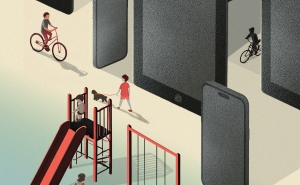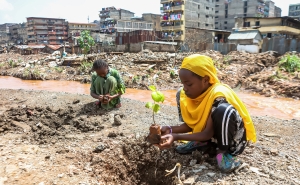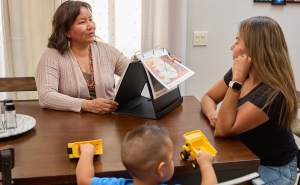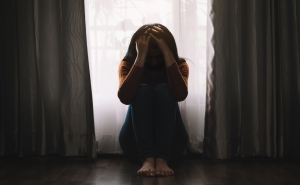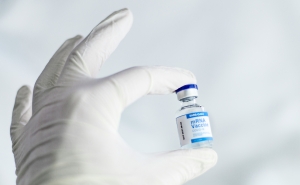COVID-19 and Stigma
Why shame and blame won’t help fight the pandemic, and what we should be focusing on instead
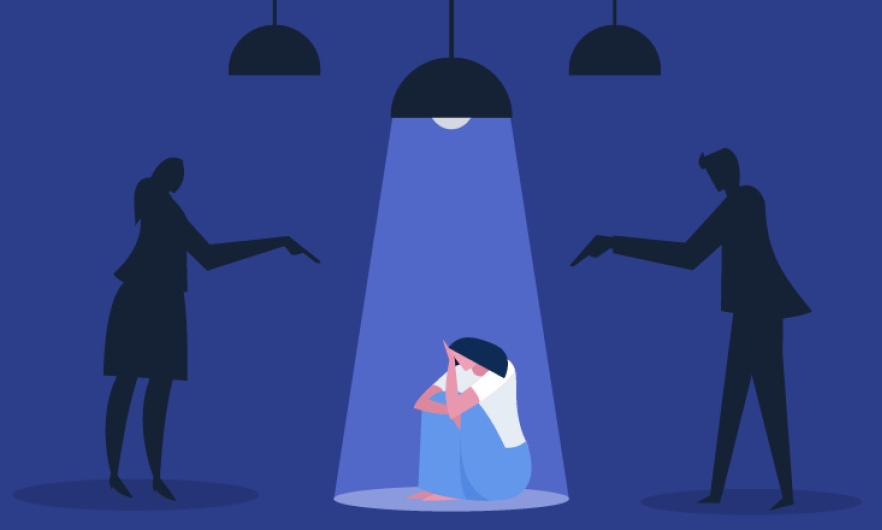
CONTRIBUTIONS FROM KERI ALTHOFF, BETH MCGINTY, AND ELIZABETH STUART
As COVID-19 infections rage across the country, one in four Americans associate shame with COVID-19, the National Johns Hopkins University Pandemic Pulse project found.
This stigma of COVID-19 “stops people from accessing health services and prevents public health measures from effectively controlling pandemics,” says Winnie Byanyima, executive director of UNAIDS. Pandemic Pulse findings underscore this—people reported being hesitant to notify others they may have exposed or to seek medical care unless their symptoms got worse.
Mental health researchers and practitioners Laura Murray, PhD, Beth McGinty, PhD, and Elizabeth Stuart, PhD, AM, and epidemiologist Keri Althoff, PhD, discuss how COVID-19 became so stigmatizing, the harm that shame and blame can cause, and how to combat this polarization on both macro and micro levels.
Why has COVID-19 become so stigmatizing?
There could be a wide range of reasons. For example, COVID-19 is a new virus that experts have learned more about over time with the science constantly evolving. This leads to changes in recommendations with new understandings, which can create confusion, frustration, and mistrust.
Ongoing beliefs about COVID-19 are widely diverse. In addition, COVID-19 mitigation strategies like wearing masks and social distancing have been politicized, which has led to variation in recommendations and messages across different states.
Human nature is to seek meaning and answer the question “Why?” Our emotions and thoughts largely depend on the why. As an example of this human condition, if we were asked to donate a portion of our income to a charitable fund, we would want to know why, and the answer to that question would largely dictate our feelings toward it. Or if we were being moved to a different group within our work organization, we would want to know why. In business, effective leaders are ones that are seen as transparent about explaining the why behind decisions—and thus get people to follow them. When we as humans do not understand the why, this often leads to frustration and disempowerment.
This need for us as humans to understand the -why also relates to COVID. For example, it is human nature to want to know “why” we should wear a mask, and that would largely dictate our feelings toward it. So when the guidance on mask wearing changed during the pandemic and people were asked to wear a mask after previously having been told not to, an explanation of how new data showed mask-wearing reduced transmission (and reduced concerns about limited supply for health care workers) was critical to understanding the why. Similarly, for those who become infected with COVID-19, there is often this desire to know why—what did they do that led to this?
What, specifically, may feel shameful about COVID?
In part, people may feel judged by others or themselves if they themselves get sick, for example thinking, “I did this to myself” or “This is my fault for doing x.” These types of thoughts, in turn, could lead to feelings of shame.
There could also be shaming by others of people who become ill with COVID for taking risks that they themselves might not be willing to take, such as traveling or gathering in groups. Part of this, again, may be human nature to try to explain why someone is sick. This also helps all of us try to make sense of which activities are more or less dangerous, especially within a context with widely varying recommendations from health officials and agencies. It is also important to remember that different people have different needs—for example, some people are essential workers, thus by necessity doing “riskier” activities than are people who can stay home and isolate more easily.
The reality is that while we know that some activities are riskier than others, we still don’t fully understand COVID-19 transmission. So, while these are normal thoughts to have, to counteract the related stigma, you could challenge them by replacing them with “I did x, which may have been a risk, but I don’t know exactly how much risk, and I thought it would be okay” or “It was a low-risk activity, but I was unlucky.”
How is shame making the pandemic worse?
One of the clearest impacts of stigma associated with COVID-19 is that if people are hesitant to tell others that they might have inadvertently exposed them, the virus will keep circulating unchecked. For example, a coworker might not disclose a potential exposure for fear of angering others or being fired. Or a family member may not disclose a COVID-19 positive test because they don’t want their child to be “shunned”—or not allowed to go to school.
A second key consequence is that shame and blame also contribute to mental health issues, which we know are high during the pandemic.
Do we see shame with other health problems?
Oh, yes! Some health issues are more laden with stigma problems, such as STIs and HIV, but even common health issues like heart trouble have some degree of shame: “They/I must eat poorly” or act in other ways that are “risky.” Feeling bad about an action or behavior is common and something all of us experience regularly.
Shame becomes more of an issue when we take the idea of something being “not a great action” and conclude a broader perception of “therefore, I am a bad person” or “they are a bad person.” This thought is unhelpful and most often inaccurate. Research shows that broad maladaptive thought patterns like these lead to a host of mental/behavioral/emotional health problems.
How might messaging need to change to reduce some of the tension?
To minimize stigma associated with COVID-19, leaders of all kinds could encourage and model mitigation behaviors such as mask wearing and social distancing and condemn harassment and violence toward people who are following public health guidelines. Simple praise to each other—like “thank you for sharing information about the close contact” or “thank you for wearing a mask”—can go a long way if done as a collective society. Behavioral principles clearly support that if we are praised for something, we are much more likely to do it. Leaders of organizations can also get ahead by making public statements that disclosure of COVID-19 exposure or infection will NOT lead to loss of job or other detrimental effects.
Solutions-oriented messaging is key; we need clear and direct messaging about what people can do to contain the virus and what they should do if, despite their best efforts, they become infected. Communication research shows that messages that focus on solutions can overcome feelings of helplessness and frustration that can lead to victim-blaming and stigma. It’s also important to emphasize that as community transmission continues to spike, even those who are very careful may be at risk of becoming ill with COVID-19. Things may be low risk, but that doesn’t mean zero risk.
Research on other stigmatized conditions, like substance use disorders, shows that media coverage can reduce stigma. Sympathetic narratives combining emotionally compelling depictions of individuals and messages about the systemic causes of their health issue can help audiences recognize that forces beyond the person’s control contributed to their condition. Emphasizing structural factors like the need to take public transportation in order to get to work or the need to continue working in an essential job might reduce stigma toward people with COVID-19.
How can we as individuals help?
It’s important for us to be there for one another and have grace and empathy. If a close contact tells you that you may have inadvertently been exposed, thank them. Let them know you appreciate their honesty, bravery, and desire to watch out for others. Then, follow CDC guidance for quarantine. If you test positive or develop symptoms, follow health department guidance, which may include contacting others that you may have inadvertently exposed. Blaming others and being angry will not help any of us get through this unprecedented pandemic.
If a friend or relative declines an invitation to see you in person, accept that as their decision about the risks involved, both to themselves and to you. They may have known exposures already that they do not want to bring to you, or you may not be aware of an underlying condition that puts them at greater risk for severe illness. Instead, you could “reach in” to connect with that person.
It is a normal human reaction to have emotions when you learn you test positive, or if someone tells you that you have been exposed. If you feel angry and want to post something, yell, or shame someone, take some time to think through the situation. Here are some things you can try:
- Take two or three deep breaths, clearing your mind and slowing your physiological reaction—preferably before you react.
- Write down and feel free to be honest with your thoughts and emotions. To yourself, it’s okay to say that you are angry and fearful. It is a normal human response to try to figure out the why, and find someone or something you can put blame on—including yourself.
- Challenge those thoughts by writing down some thoughts that are more helpful, such as:
- “It’s important for me to know this information so we can help the greater good.”
- “They or I could have run into this virus in many different ways.”
- “We have done the best we can to be safe.”
- “Getting mad at the situation won’t do much good.”
What’s most important to consider right now?
Even if you are following public health guidance—wearing a mask, staying at home as much as possible, and socially distancing from others not in your immediate household—there’s still a possibility that you could be exposed to or become ill with COVID-19, particularly when community transmission is high.
Although vaccines are starting to roll out to those at most risk, this pandemic will not be over any time soon, and we will need collective empathy more than ever in the months to come. Part of keeping ourselves and one another safe is trying to avoid contributing to shame and stigma.
Keri Althoff, PhD ’08, MPH ’05, is an associate professor in Epidemiology with a joint appointment at the School of Medicine. She is the Provost’s Fellow for Research Communication at Johns Hopkins.
Beth McGinty, PhD, is an associate professor in Health Policy and Management with a joint appointment in Mental Health.
Laura K. Murray, PhD, MA, is a clinical psychologist and a senior scientist in Mental Health at the Bloomberg School.
Elizabeth Stuart, PhD, AM, is the associate dean for Education and a professor in Mental Health, Biostatistics, and Health Policy and Management at the Bloomberg School. She was recently appointed as a Bloomberg Professor of American Health.
RELATED CONTENT
- How to ‘Reach In” to Meaningfully Connect with Loved Ones From Afar
- How Can I Ask My Friends to Wear Masks? Talking to Friends, Family, Kids, and Coworkers About COVID-19 Safety
- Mental Health Q&A: Dealing with Election Anxiety, Hard Decisions about Holiday Plans, and Pandemic Fatigue (podcast)
- Mental Health Q&A: Dealing with Unique Stressors, Adjusting to “Back to School,” and Preparing for Winter Months

